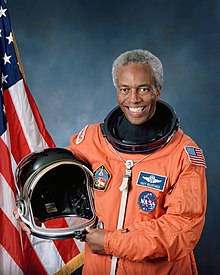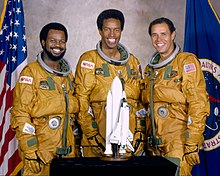Guion Guy Stewart Bluford | |
|---|---|
 | |
| Born | Guion Stewart Bluford Jr. November 22, 1942 Philadelphia, Pennsylvania, U.S. |
| Education | Pennsylvania State University (BS) Air University (MS, PhD) University of Houston (MBA) |
| Space career | |
| NASA astronaut | |
| Rank | Colonel, USAF |
Time in space | 28d 16h 33m |
| Selection | NASA Group 8 (1978) |
| Missions | STS-8 STS-61-A STS-39 STS-53 |
Mission insignia |     |
Guion Stewart Bluford Jr. (born November 22, 1942) is an American aerospace engineer, retired United States Air Force (USAF) officer and fighter pilot, and former NASA astronaut, in which capacity he became the first African American to go to space.[1][2][a] While assigned to NASA, he remained a USAF officer rising to the rank of colonel. He participated in four Space Shuttle flights between 1983 and 1992. In 1983, as a member of the crew of the Orbiter Challenger on the mission STS-8, he became the first African American in space as well as the second black person in space, after Cuban cosmonaut Arnaldo Tamayo Méndez.[3]
Born in Philadelphia, Bluford graduated from Overbrook High School in 1960. He received a Bachelor of Science degree in aerospace engineering from Pennsylvania State University in 1964, a Master of Science degree in Aerospace Engineering from the Air Force Institute of Technology (AFIT) in 1974, a Doctor of Philosophy degree in Aerospace Engineering with a minor in Laser Physics, again from AFIT, in 1978, and a Master of Business Administration degree from the University of Houston–Clear Lake in 1987.[4] He has also attended the Wharton School of Business of the University of Pennsylvania.[5]
His hobbies include reading, swimming, jogging, racquetball, handball, scuba diving and golf.[6] He married Linda Tull in 1964 and has two sons.[7]
Bluford attended pilot training at Williams Air Force Base, and received his pilot wings on January 19 for the Aeromechanics Division and as branch chief of the Laboratory's Aerodynamics and Airframe Branch. He has written and presented several scientific papers in computational fluid dynamics.[6]
He has logged over 5,200 hours of jet flight time in the T-33, T-37, T-38, F-4C, U-2/TR-1, and F-5A/B aircraft, including 1,300 hours as a T-38 instructor pilot. He also has an FAA commercial pilot license.[6]

Bluford was selected to become a NASA astronaut in January 1978 as a part of NASA astronaut group 8.[8] He was one of several astronauts recruited by Nichelle Nichols as part of a NASA effort to increase the number of minority and female astronauts.[9] They trained for a year and were officially designated as astronauts in August 1979.[6][10] His technical assignments have included working with Space Station operations, the Remote Manipulator System (RMS), Spacelab systems and experiments, Space Shuttle systems, payload safety issues and verifying flight software in the Shuttle Avionics Integration Laboratory (SAIL) and in the Flight Systems Laboratory (FSL). Bluford was a mission specialist on STS-8, STS-61-A, STS-39, and STS-53.[11]
Bluford's first mission was STS-8, which launched from Kennedy Space Center, Florida, on August 30, 1983. This was the third flight for the Orbiter Challenger and the first mission with a night launch and night landing. During the mission, the STS-8 crew deployed the Indian National Satellite (INSAT-1B);[12] tested the Canadian-built robotic arm (the Shuttle Remote Manipulator System (SRMS) or Canadarm) with the Payload Flight Test Article (PFTA); operated the Continuous Flow Electrophoresis System (CFES) with live cell samples; conducted medical measurements to understand bio-physiological effects of space flight; and activated four "Getaway Special" canisters. STS-8 completed 98 orbits of the Earth in 145 hours before landing at Edwards Air Force Base, California, on September 5, 1983.[6]

Bluford then served on the crew of STS-61-A, the German D-1 Spacelab mission, which launched from Kennedy Space Center on October 30, 1985. This mission was the first to carry eight crew members, the largest crew to fly in space, and included three European payload specialists. This was the first dedicated Spacelab mission under the direction of the German Aerospace Research Establishment (DFVLR) and the first U.S. mission in which payload control was transferred to a foreign country (German Space Operations Center, Oberpfaffenhofen, Germany). During the mission, the Global Low Orbiting Message Relay Satellite (GLOMR) was deployed from a "Getaway Special" (GAS) container, and 76 experiments were performed in Spacelab in such fields as fluid physics, materials processing, life sciences, and navigation. After completing 111 orbits of the Earth in 169 hours, Challenger landed at Edwards Air Force Base on November 6, 1985.[6]
Bluford also served on the crew of STS-39, which launched from Kennedy Space Center on April 28, 1991, aboard the Orbiter Discovery. The crew gathered aurora, Earth-limb, celestial, and Shuttle environment data with the AFP-675 payload. This payload consisted of the Cryogenic Infrared Radiance Instrumentation for Shuttle (CIRRIS-1A) experiment, Far Ultraviolet Camera experiment (FAR UV), the Uniformly Redundant Array (URA), the Quadrupole Ion Neutral Mass Spectrometer (QINMS), and the Horizon Ultraviolet Program (HUP) experiment. The crew also deployed and retrieved the SPAS-II which carried the Infrared Background Signature Survey (IBSS) experiment. The crew also operated the Space Test Payload-1 (STP-1) and deployed a classified payload from the Multi-Purpose Experiment Canister (MPEC). After completing 134 orbits of the Earth and 199 hours in space, Discovery landed at the Kennedy Space Center on May 6, 1991.[6]
Bluford's last mission was STS-53, which launched from Kennedy Space Center on December 2, 1992. The crew of five deployed the classified Department of Defense payload DOD-1 and then performed several Military-Man-in-Space and NASA experiments. After completing 115 orbits of the Earth in 175 hours, Discovery landed at Edwards Air Force Base on December 9, 1992.[6]
With the completion of his fourth flight, Bluford has logged over 688 hours in space.[6]
Bluford, an Eagle Scout, was designated as the emissary to return the Challenger flag to Boy Scout Troop 514 of Monument, Colorado, in December 1986. On December 18 of that year, he presented the flag to the troop in a special ceremony at Falcon Air Force Base.[13]
Bluford left NASA and retired from the USAF in July 1993 to take the post of Vice President/General Manager, Engineering Division of NYMA, Greenbelt, Maryland. In May 1997, he became Vice President of the Aerospace Sector of Federal Data Corporation and in October 2000, he became the Vice President of Microgravity R&D and Operations for the Northrop Grumman Corporation. He retired from Northrop Grumman in September 2002 to become the President of Aerospace Technology, an engineering consulting organization in Cleveland, Ohio.[6]
Bluford was inducted into the International Space Hall of Fame in 1997,[11] the United States Astronaut Hall of Fame in 2010,[14] and the National Aviation Hall of Fame in 2019.[15]
In 2002, scholar Molefi Kete Asante listed Bluford on his list of 100 Greatest African Americans.[16] In 2006, Bluford was recognized as a distinguished alumnus of Penn State by being selected as the Grand Marshal for his alma mater's Homecoming celebration.[17]
In 2020, Ohio Governor Mike DeWine awarded him the Ohio Distinguished Service Medal: Ohio's highest non-combat decoration for service.

Bluford is a member and a fellow of many organizations:[6]
He also received honorary doctorate degrees from Florida A&M University,[27] Texas Southern University, Virginia State University, Morgan State University, Stevens Institute of Technology, Tuskegee Institute, Bowie State College, Thomas Jefferson University, Chicago State University, Georgian Court University, Drexel University, Kent State University, Central State University and the University of the Sciences.[6]
Bluford Drew Jemison STEM Academy West, a middle/high school in Baltimore, Maryland, is named in his honor (along with Charles Drew and Mae Jemison). On October 8, 2021, a building on the main campus of The Pennsylvania State University in its Innovation Park was named the Guion S. Bluford Jr. Building in his honor.
On July 25, 2017, the Philadelphia Orchestra premiered Hold Fast to Dreams, a 25-minute piece for orchestra and choir in four movements, commissioned by the Mann Center for the Performing Arts in honor of Bluford, and written by composer Nolan Williams Jr.[28][29]